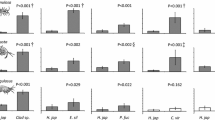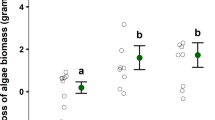Abstract
The invasive red alga Gracilaria vermiculophylla has quickly spread across Europe, but it is unclear whether its success is based on a high tolerance to variations in environmental conditions or to the absence of native grazers that feed on this alga. We tested whether native invertebrate grazers prefer native algae to G. vermiculophylla. Feeding preferences of three common herbivores were quantified when offered G. vermiculophylla and native Fucus vesiculosus, Ceramium virgatum, and Ulva intestinalis in no-, two- and multiple-choice trials. Herbivore growth was measured when fed each of the algae separately. Grazers consumed G. vermiculophylla in no-choice trials, but avoided generally this alga when having a choice. U. intestinalis was always preferred over G. vermiculophylla, and grazers fed with U. intestinalis grew faster than those fed with G. vermiculophylla. We conclude that grazers avoid G. vermiculophylla to most native algae, which may benefit G. vermiculophylla in northern European estuaries.





Similar content being viewed by others
References
Amsler C, Fairhead V (2006) Defensive and secondary chemical ecology of brown algae. Adv Bot Res 43:1–91
Bellorin AM, Oliveira MC, Oliveira EC (2004) Gracilaria vermiculophylla: a western Pacific species of Gracilariaceae (Rhodophyta) first recorded from the eastern Pacific. Phycol Res 52:69–79
Boudouresque CF, Verlaque M (2002) Biological pollution in the Mediterranean Sea: invasive versus introduced macrophytes. Mar Pollut Bull 44:32–38
Britton-Simmons KH (2004) Direct and indirect effects of the introduced alga Sargassum muticum on benthic, subtidal communities of Washington State, USA. Mar Ecol Prog Ser 277:61–78
Cacabelos E, Olabarria C, Incera M, Troncoso JS (2010) Do grazers prefer invasive seaweeds? J Exp Mar Biol Ecol 393:182–187
Cebrián J, Duarte CM (1994) The dependence of herbivory on growth rate in natural plant communities. Funct Ecol 8:518–525
Chesson J (1983) The estimation and analysis of preference and its relationship to foraging models. Ecology 64:1297–1304
Denton AB, Chapman ARO (1991) Feeding preferences of gammarid amphipods among four species of Fucus. Mar Biol 109:503–506
Duffy JE, Hay ME (1991) Food and shelter as determinants of food choice by an herbivorous marine amphipod. Ecology 72:1286–1298
Duffy JE, Hay ME (2000) Strong impacts of grazing amphipods on the organization of a benthic community. Ecol Monogr 70:237–263
Dworjanyn SA, Wright JT, Poul NA, de Nys R, Steinberg PD (2006) Cost of chemical defense in the red alga Delisea pulchra. Oikos 113:13–22
Elton CS (1958) The ecology of invasions by animals and plants. Methuen, London
Engkvist R, Malm T, Nilsson J (2004) Interaction between isopod grazing and wave action: a structuring force in macroalgal communities in the southern Baltic Sea. Aquat Ecol 38:403–413
Forslund H, Wikström SA, Pavia H (2010) Higher resistance to herbivory in introduced compared to native populations of a seaweed. Oecologia 164:833–840
Freshwater DW, Montgomery F, Greene JK, Hammer RM, Williams M, Whitfield PE (2006) Distribution and identification of an invasive Gracilaria species that is hampering commercial fishing operations in southeastern North Carolina, USA. Biol Invasions 8:631–637
Geertz-Hansen O, Sand-Jensen K, Hansen DF, Christiansen A (1993) Growth and grazing control of the abundance of the marine macroalga, Ulva lactuca L. in a eutrophic Danish estuary. Aquat Bot 46:101–109
Gianotti AL, McGlathery KJ (2001) Consumption of Ulva lactuca (Chlorophyta) by the omnivoriuos mud snail Ilyanassa obsolete. J Phycol 37:1–7
Goecker ME, Kåll SE (2003) Grazing preferences of marine isopods and amphipods on three prominent algal species of the Baltic Sea. J Sea Res 50:309–314
Hay ME, Fenical W (1988) Marine plant-herbivore interactions: the ecology of chemical defense. Annu Rev Ecol Syst 19:111–145
Hayward PJ, Ryland JS (2002) Handbook of the marine fauna of North-West Europe. Oxford University Press, Oxford
Keane RM, Crawley MJ (2002) Non-native plant invasions and the enemy release hypothesis. Trends Ecol Evol 17:164–170
Kotta J, Orav-Kotta H, Paalme T, Kotta I, Kukk H (2006) Seasonal changes in situ grazing of the mesoherbivores Idotea baltica and Gammarus oceanicus on the brown algae Fucus vesiculosus and Pilayella littoralis in the central Gulf of Finland, Baltic Sea. Hydrobiologia 554:117–125
Kraufvelin P, Salovius S, Christie H, Moy F, Karez R, Pedersen MF (2006) Eutrophication-induced changes in benthic algae affect the behavior and fitness of the marine amphipod Gammarus locusta. Aquat Bot 84:199–209
Littler MM, Littler DS (1980) The evolution of thallus form and survival strategies in benthic marine macroalgae: field and laboratory tests of the functional form model. Am Nat 116:25–44
Lubchenco J (1978) Plant species-diversity in a marine inter-tidal community—importance of herbivore food preference and algal competitive abilities. Am Nat 112:23–39
Manly BFJ (1993) Comments on design and analysis of multiple-choice feeding-preference experiments. Oecologia 93:149–152
Manly BFJ (1995) Measuring selectivity from multiple choice feeding-preference experiments. Biometrics 51:709–715
Mattson WJ (1980) Herbivory in relation to plant nitrogen content. Annu Rev Ecol Syst 11:119–161
Monteiro CA, Engelen AH, Santos ROP (2009) Macro- and mesoherbivores prefer native seaweeds over the invasive brown seaweed Sargassum muticum: a potential regulating role on invasions. Mar Biol 156:2505–2515
Nejrup LB, Pedersen MF (2010) Growth and biomass development of the introduced red alga Gracilaria vermiculophylla is unaffected by nutrient limitation and grazing. Aquat Biol 10:249–259
Nejrup LB, Pedersen MF (2012) Low and variable salinity may limit the fitness of the invasive red alga Gracilaria vermiculophylla. Eur J Phycol (in press)
Nicotri ME (1980) Factors involved in herbivore food preference. J Exp Mar Biol Ecol 42:13–26
Nyberg CD, Wallentinus I (2005) Can species traits be used to predict marine macroalgal introductions? Biol Invasions 7:265–279
Nyberg CD, Thomsen MS, Wallentinus I (2009) Flora and fauna associated with the introduced red alga Gracilaria vermiculophylla. Eur J Phycol 44:395–403
Nylund GM, Cervin G, Persson F, Hermansson M, Steinberg PD, Pavia H (2008) Seaweed defense against bacteria: a poly-brominated 2-heptanone from the red alga Bonnemaisonia hamifera inhibits bacterial colonisation. Mar Ecol Prog Ser 369:39–50
Nylund GM, Weinberger F, Rempt M, Pohnert G (2011) Metabolomic assessment of induced and activated chemical defence in the invasive red alga Gracilaria vermiculophylla. PLoS ONE. doi:10.1371/journal.pone.0029359
Paul VJ, Hay ME (1986) Seaweed susceptibility to herbivory: chemical and morphological correlates. Mar Ecol Prog Ser 33:255–264
Paul NA, de Nys R, Steinberg PD (2006) Seaweed–herbivore interactions at a small scale: direct tests of feeding deterrence by filamentous algae. Mar Ecol Prog Ser 323:1–9
Pavia H, Carr H, Åberg P (1999) Habitat and feeding preferences of crustacean meso-herbivores inhabiting the brown seaweed Ascophyllum nodosum (L.) Le Jol. and its epiphytic macroalgae. J Exp Mar Biol Ecol 236:15–32
Pedersen MF, Borum J (1996) Nutrient control of algal growth in estuarine waters. Nutrient limitation and the importance of nitrogen requirements and nitrogen storage among phytoplankton and species of macroalgae. Mar Ecol Prog Ser 142:261–272
Pedersen MF, Stæhr PA, Wernberg T, Thomsen MS (2005) Biomass dynamics of exotic Sargassum muticum and native Halidrys siliquosa in Limfjorden, Denmark: implications of species replacements on turnover rates. Aquat Bot 83:31–47
Quinn GP, Keough MJ (2002) Experimental design and data analysis for biologists. Cambridge University Press, Cambridge
Rasmussen E (1973) Systematics and ecology of the Isefjord fauna (Denmark). Ophelia 11:1–507
Rejmánek M, Richardson DM (1996) What attributes make some plants species more invasive? Ecology 77:1655–1660
Rhode S, Molis M, Wahl M (2004) Regulation of anti-herbivore defence by Fucus vesiculosus in response to various cues. J Ecol 92:1011–1018
Roa R (1992) Design and analysis of multiple-choice feeding-preference experiments. Oecologia 89:509–515
Rueness J (2005) Life history and molecular sequences of Gracilaria vermiculophylla (Gracilariales, Rhodophyta), a new introduction to European waters. Phycologia 44:120–128
Ruiz GM, Carlton JT, Grosholz ED, Hines AH (1997) Global invasions of marine and estuarine habitats by non-indigenous species: mechanisms, extent, and consequences. Am Zool 37:621–632
Schaffelke B, Evers D, Walhorn A (1995) Selective grazing of the isopod Idotea baltica between Fucus evanescens and F. vesiculosus from Kiel Fjord (western Baltic). Mar Biol 124:215–218
Schaffelke B, Smith JE, Hewitt CL (2006) Introduced macroalgae: a growing concern. J Appl Phycol 18:529–541
Sfriso A, Maistro A, Andreoli C, Moro I (2010) First record of Gracilaria vermiculophylla (Gracilariales, Rhodophyrta) in the Po Delta Lagoons, Mediterranean Sea (Italy). J Phycol 46:1024–1027
Strong JA, Maggs CA, Johnson MP (2009) The extent of grazing release from epiphytism for Sargassum muticum (Phaeophyceae) within the invaded range. J Mar Biol Ass UK 89:303–314
Thomsen MS, McGlathery KJ (2007) Stress tolerance of the invasive macroalgae Codium fragile and Gracilaria vermiculophylla in a soft-bottom turbid lagoon. Biol Invasions 9:499–513
Thomsen MS, Gurgel CFD, Fredericq S, McGlathery KJ (2006) Gracilaria vermiculophylla (Rhodophyta, Gracilariales) in Hog Island Bay, Virginia: a cryptic alien and invasive macroalga and taxonomic correction. J Phycol 42:139–141
Thomsen MS, Staehr P, Nyberg C, Schwærter S, Krause-Jensen D, Silliman BR (2007) Gracilaria vermiculophylla (Ohmi) Papenfuss, 1967 (Rhodophyta, Gracilariaceae) in Northern Europe, with emphasis on Danish conditions, and what to expect in the future. Aquat Inv 2:83–94
Vandendriessche S, De Keersmaecker G, Vincx M, Degraer S (2006) Food and habitat choice in floating seaweed clumps: the obligate opportunistic nature of the associated macrofauna. Mar Biol 149:1499–1507
Weinberger F, Buchholz B, Karez R, Wahl M (2008) The invasive red alga Gracilaria vermiculophylla in the Baltic Sea: adaptation to brackish water may compensate for light limitation. Aquat Biol 3:251–264
Wikström SA, Steinarsdottir MB, Kautsky L, Pavia H (2006) Increased chemical resistance explains low herbivore colonization of introduced seaweed. Oecologia 148:593–601
Williams SL, Smith JE (2007) A global review of the distribution, taxonomy, and impacts of introduced seaweeds. Annu Rev Ecol Evol S 38:327–359
Wolfe LM (2002) Why alien invaders succeed: support for the escape-from-enemy hypothesis. Am Nat 160:705–711
Yao Y (1965) An approximate degrees of freedom solution to the multivariate Behrens-Fisher problem. Biometrika 52:139–147
Acknowledgments
PhD-student Lars B. Nejrup was supported by a grant number 272-05-0161 (CIPE) while Morten F. Pedersen and Jonas Vinzent were supported by grant #272-08-0577 (MARINVA) from the Danish Natural Sciences Research Council. We like to thank Gary T. Banta for statistical advice and two anonymous referees for providing helpful and constructive comments to the initial version of the manuscript.
Author information
Authors and Affiliations
Corresponding author
Additional information
Communicated by F. Bulleri.
Rights and permissions
About this article
Cite this article
Nejrup, L.B., Pedersen, M.F. & Vinzent, J. Grazer avoidance may explain the invasiveness of the red alga Gracilaria vermiculophylla in Scandinavian waters. Mar Biol 159, 1703–1712 (2012). https://doi.org/10.1007/s00227-012-1959-9
Received:
Accepted:
Published:
Issue Date:
DOI: https://doi.org/10.1007/s00227-012-1959-9




